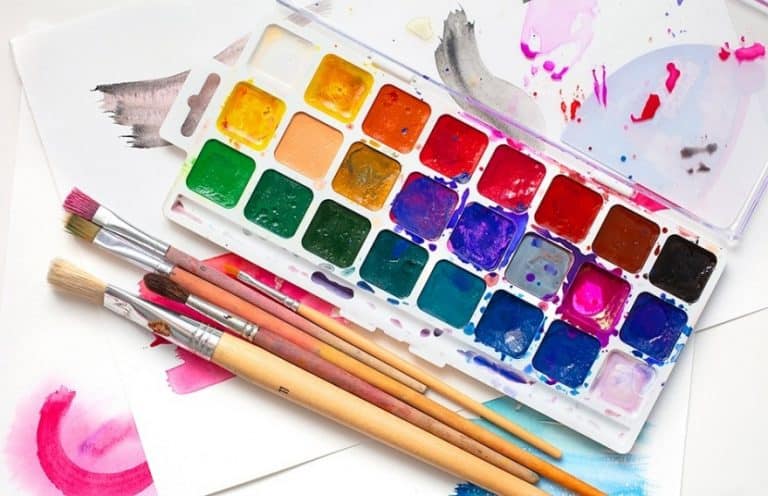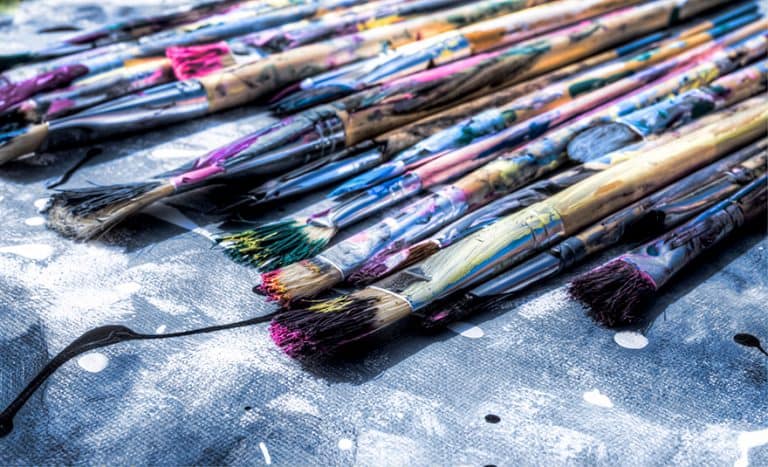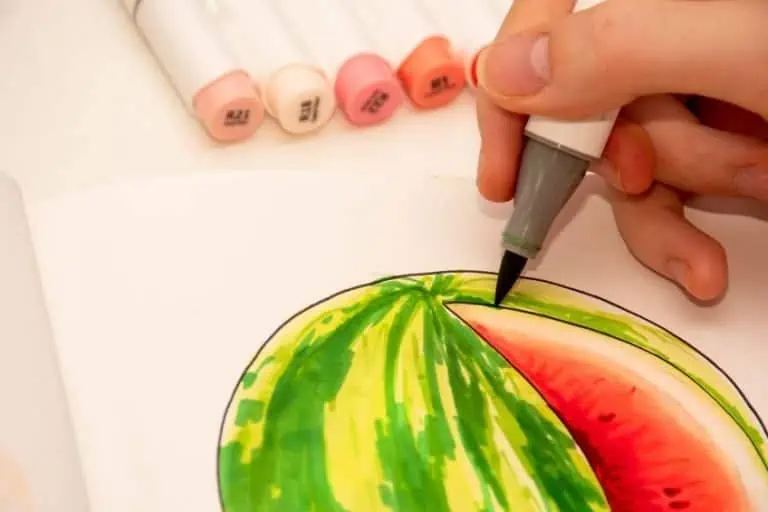Painting Polymer Clay – How to Paint Polymer Clay
This post may contain affiliate links. We may earn a small commission from purchases made through them, at no additional cost to you.
There are many forms and types of arts and crafts, all offering fun ways to create new things. Painting clay is one of these amazing and fun activities everyone can enjoy. Polymer clay is a popular choice as you can put it into the oven to cure. You can also paint polymer clay and create details for jewelry, beads, miniature figures, and lots more. When painting clay you can also imitate various materials like wood. There are numerous possibilities for creativity but let us now focus on painting polymer clay.
Table of Contents
A Closer Look at Polymer Clay
Polymer clay is popular because it is easy to work with and versatile. You do not need any fancy oven to bake the clay, so it can be done at home in an ordinary kitchen oven. The polymer clay is made from polymers, resins, fillers, and, in some cases, coloring agents. The clay is not a natural product and has polyvinyl chloride (PVC) as its base. Everybody can use polymer clay, although supervising younger children is advised. Polymer clay is even used by professional artists like those in the movie industry. You can purchase the clay in a variety of different colors. Acrylic paints are usually used to paint on the polymer to add finer details. Some color the clay using various methods like adding chalk, inks, or even powdered make-up. Depending on the look you are going for, you can also, sand, buff, and seal your clay artwork, which can also give a nice shine to the surface.

Types of Paint Polymer Clay
Many would say that the best polymer clay paint is water-based. But are there other types of paint options? Acrylic paints might be the top choice, but other choices could work and produce amazing results. One exception is watercolor paints, these can be difficult to work with and may cause bubbling if mixed into the clay before baking due to the higher water content.
Whenever experimenting with paints, it is a good idea to test out the paint first before moving on to your final project item. Here is a few more paint for polymer clay ideas you might want to consider and further ideas on how to color polymer clay.
- Oil paints: these can work well but tend to take a long time to dry and can be applied to cured clay. But it needs to be re-cured to set the paint. You can also mix it into unbaked raw clay, which can produce some amazing marble effects
- Alcohol inks: these are made of dye that is dissolved in an alcohol base. These can be added into or applied to the surface of the raw clay, or they can be painted onto the baked clay.

How to Color Polymer Clay?
The simplest method is to purchase clay that already has a color. These color clay bases can then also be blended to create different shades of color. However, there are ways to color polymer clay yourself using various methods including acrylic paints. You do not want to leave any water within the clay before baking, so using other options besides acrylic paints or other water-based options might be best. If you do use water-based paint like acrylics, you should leave the colored clay to dry for at least two to three days before baking.
Depending on how you color your clay, it will affect the outcome. So, if you use water or alcohol-based colors, the colors might come out less vibrant than if you use color pigments to mix into the clay. The color pigments should offer more vibrant and stronger colors.
Mica Powders: Mica powders are a great option for pearl or metallic color effects and are best applied before baking. You might also want to try out using eye shadow, although since products contain different ingredients, you will have to experiment for the effect you want. There are many ways you can use mica powders from mixing it into the clay before baking to brushing it on to produce a shine.
Chalk Powder: You need to turn the chalk into a powder that can then be added to the raw polymers, or you can create chalk paint. The chalk powder is popular as a surface treatment, however, as with all of these options, experiment to find out what more you can do.
Other Methods: You can also use different types of inks like acrylic or alcohol inks, foils, finely shaved crayon shavings, and paint markers to create unique ideas. Sometimes, these different ideas can be combined to create different effects. So, there is not only one way when it comes to paint for polymer clay, there are many methods that could be fun to experiment with.

Table of How to Color Polymer Clay:
| Acrylic Paints | Alcohol-Based Colors (Alcohol ink) | Mica Powders | Oil-Based Paints | |
| Cost | Readily available and affordable. Artist-grade can be expensive | Easy to come by but expensive | Expensive | Expensive |
| Baking Instructions | Wait at least two to three days before baking if acrylic paints have been added to raw clay | Wait for 3 to 4 hours for the alcohol to evaporate in raw clay | Bake as normal, no water or alcohol needs to evaporate | Paint the cured clay, and to set, bake again briefly |
| When to Apply | Can be used to paint or color before or after baking | Can be applied to baked or unbaked polymer | Apply before baking onto the surface or mixed in | Can be used to mix into raw clay or painted onto cured clay |
How to Paint Polymer Clay?
As mentioned, when it comes to paint for polymer clay, the best choice would be water-based acrylic paint. Artist-grade paints will do a more excellent painting job; however, some good quality craft acrylic paints should also be fine. Never use something like nail polish to add color and gloss onto polymer clay, as it will begin to dissolve the clay, or it could eventually turn sticky. Some clay brands do not take well to painting, so it is best to test out the paint on the clay before using it. One of the more popular brands for polymer painting, is Sculpey.
After you have painted, you can apply a sealer. However, this step is not necessary if you have used clay that already has a color, as it is durable in itself. A sealant would just give it an extra shine, however, if you have painted it or added other elements, a sealant coat is a good idea. The sealer can be an acrylic sealer, wax, varnish, or even a liquid epoxy. The Sculpey brand also has its own glaze. To get a gloss look for the already colored clays without applying a sealer, you can simply sand and buff.

Basic Guide of How to Paint Polymer Clay After Baking
Easily put some finishing details onto your polymer clay creations after you have baked the clay in the oven. The steps are fairly simple when using the right products, you should be able to complete your unique art piece in no time.
- Take your clay and mold it into your desired form
- Preheat the oven to 275 degrees Fahrenheit
- Bake the clay in the oven, different clays may have different baking times so always read the product instructions
- Take out of the oven and let it cool down thoroughly before handling and painting
- A hot or warm surface can cause the paint not to adhere properly
- Apply two thin layers of Sculpey glaze with a brush. Each layer should be allowed to dry for an hour before the next layer is added. Once done, wait three hours for the glaze to fully cure before painting
- Use 150-grit sandpaper and gently sand the surface until it feels slightly rough. Do not overdo the sanding, you do not want to remove the glaze. This is simply to provide better surface adherence for the paint
- Clean and remove any dust
- Go ahead with your polymer painting using acrylic paint for the first coat
- Apply the paint in thin layers, to prevent brushstrokes
- The first layer should dry for two hours before applying a second layer and allow to dry again for two hours before handling
Sculpey Glaze helps to smooth and seal the clay once it comes out of the oven and has cooled. It helps to cover any flaws and also provides a compatible surface for different paints including acrylic paint on polymer clay and other finishes. If you do not apply the glaze and you find the clay surface is smooth after baking, you can still lightly sand the surface with 400 to 600-grit paper. Be careful if you have finer details, not to sand too much. In the case of too much detailed work, you might consider different clay brands or paints to find the right one where you do not need to sand at all.
Also, if you find that the paint does not stick to the clay after it has been baked, it could be that a thin oily film has developed over the surface. To remove, simply wipe the surface with some rubbing alcohol. Wait a few seconds and apply your paint. This is without doing any sanding or using the glaze.
How to Paint Unbaked Polymer Clay?
Do you paint polymer clay before or after baking? This depends on what you want to do, however, many prefer to paint after baking. This is because when you paint unbaked polymer clay, some paints may still contain moisture which could lead to bubbles after baking. To help with this, leave your painted polymer clay item to dry for at least two to three days before baking.
The polymer clay itself does not expand or shrink while curing, so applying the paint before baking should not be a problem. Clay, before it is baked, might also create a better bond while curing. The best way to avoid any problems is to always test out your paint on the clay to see what will happen. Some paint could also change color when heated, so testing out things will help to prevent any surprises. Also, always read the product instructions before painting or baking. The process of painting is fairly simple, create your clay item, paint, and place it in the oven. The oven temperature should be about 275 degrees Fahrenheit. If it gets too hot, it could burn the clay so try and monitor the baking process.

Creating Different Polymer Painting Effects
Polymer clay is a versatile art medium, and you can do all kinds of creative techniques. You can make it look like other types of surfaces from metal to glass and ceramic. You can also try creating other mixed media pieces besides applying paints with painting polymer clay. For example, adding metals or glass into the clay. For now, let us look at a few examples of painting effects.
- Antique Finish: When applying paint to a stamped surface, and then wiping the excess off so that some paint remains in the recesses
- Highlighting: When the paint is applied to a raised surface only
- Adding accents, swirls, and dots. Dot painting has become a popular technique, especially for things like rock painting
- Crackling effect: Apply the acrylic paint to a flat piece of raw clay and let this dry. Run this through something like a pasta maker, so that the paint cracks
- Using a soft brush, apply some metallic pigment directly to the clay before baking. Bake and apply glaze
- Once cured, apply the acrylic paints with a sponge and added water to the paint for a watercolor effect. Works best on white clay
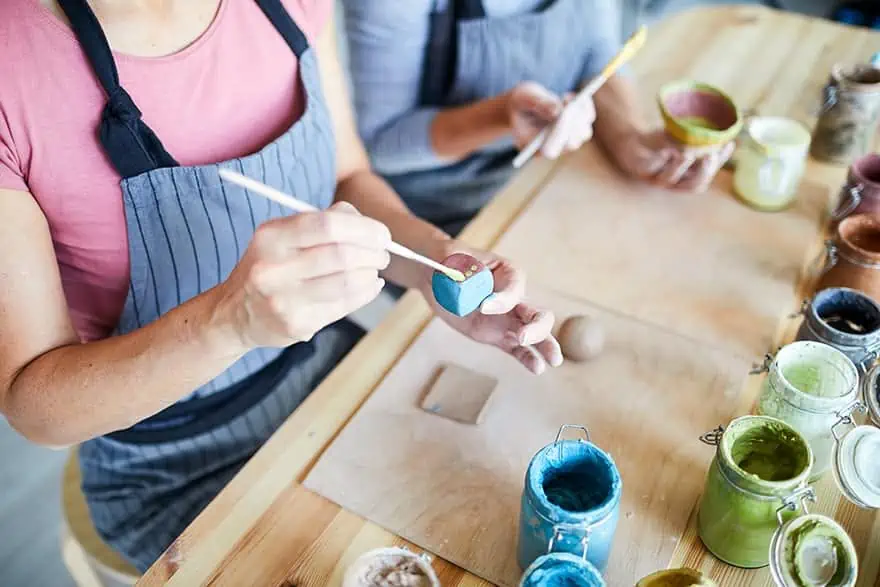
Problems and Polymer Painting
Unfortunately, simply painting polymer clay can have its problems, especially since there are so many paint ideas and mediums you can use. Sometimes, you will even need to experiment to see what happens, but for now, here are a few common issues people have experienced.
Paint Coverage
Different paints have varying consistencies and the coverage of surfaces is not the same. Some are thicker and opaque and will cover an area in a single coat. Others are watery or translucent and you will need several coats to get the look you are going for. When it comes to good color coverage and vibrancy, it is the type and amount of pigment that can make a difference. However, the pigment is what is expensive. So, if you want quality paint color you are going to have to pay a little more for artist-grade acrylic paints. Craft paints are less expensive, but you are going to have to apply more than one coat for better coverage. This is because these paints have less pigment density.
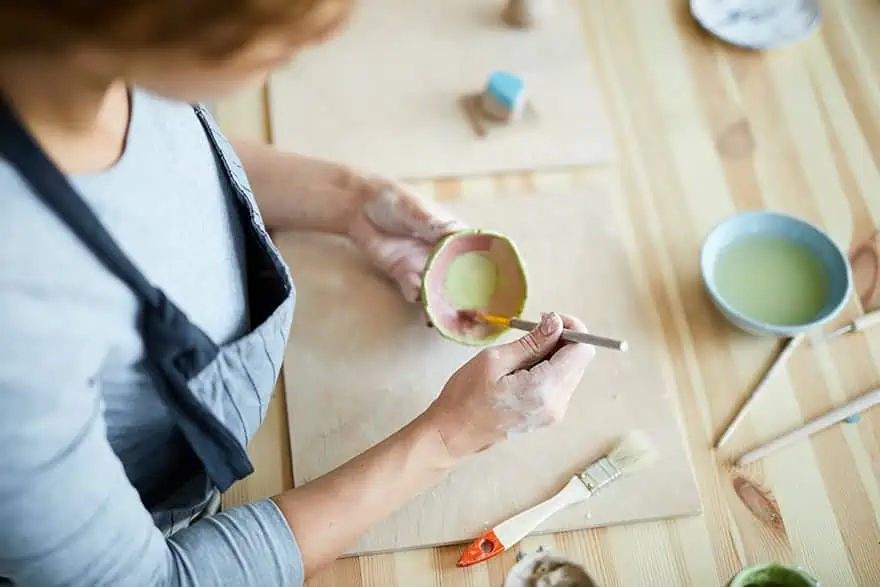
Paint Stickiness
Paints are made to work on paper effectively, so when applied to another type of surface, they will naturally have a few problems. Polymer clay is a completely different type of surface and is made from plasticized vinyl. This type of plastic can react with the acrylic paint which then softens it and causes some sticky issues. You have different polymer clay brands and each of these will react differently to the many brands of paint available. This is why you should first test the paint on your baked clay to see if it is compatible. You can remove sticky paint with a little rubbing alcohol and start over or try and cover with a sealant to hide the issue.
Color Fading
When using anything that contains a dye, be aware that these colors are not lightfast and will fade over time. Paint pigments are tougher and will last longer but will also eventually fade if placed in sunlight.

Peeling, Cracking, and Bubbling
Since the polymer is not absorbent, paint cannot be absorbed like it does when painting on paper. Paint will remain on top of the clay, which makes it is more likely that the paint will eventually peel or chip. Some paints adhere more effectively than others to different types of clay. You can improve how the paint adheres to the surface by simply lightly sanding the surface with 400 to 500-grit paper. Also, applying paint to raw polymer clay and then baking it is best, as the paint adheres better than after the clay has been baked.
In many cases, if using water-based paint on un-baked polymer clay can cause bubbling after it has been baked. This is because there is still moisture left in the clay and paint that begins to bubble when heat is applied. To help prevent this, make sure you leave the painted item to dry for at least two to three days before placing it in the oven.

Tips for Painting Polymer Clay
Polymer clay is a fun medium to work with, you can create amazing sculptures, jewelry, and lots more. When dealing with polymer clay and paint, problems can arise. So, here are a few tips to smooth things out and put more fun into the whole process.
- Lightly sanding your clay item with fine-grit paper before painting can help with paint adhering to the surface better
- Consider baking a piece again after painting a baked clay item, to set the paint and provide better adherence.
- Polymer clay should not be used on anything that is going to touch food or come into contact with food. If using cookie sheets for baking the clay, line with foil
- Polymer clay needs to be absolutely dry before baking. To test out if clay is dry enough to place in the oven, put your hand on the clay and feel if it still feels significantly colder, then leave a little longer as it still needs to dry some more
- Condition clay by kneading and stretching the clay to soften it, which helps prevent it from being brittle once it has baked
- Let the baked clay item cool slowly, switch the oven off and leave the door open. Cracks may form if the clay is exposed to drastic temperature changes when removing from the oven
- Select good quality paint that is smooth and fade-resistant
- Again, a good quality brush is also a great idea so as not to have issues with shedding bristles
- Make sure your clay item is cool once baked before painting. The paint might not adhere properly to a surface that is still warm
Frequently Asked Questions
Do you Paint Polymer Clay Before or After Baking?
When using acrylic paints, you can do both. However, if you choose to paint before baking, you should make sure the clay and paint are dry before baking. May prefer to paint after baking when the clay has cooled and is hard.
Can Food Colors be Added to Clay?
Yes, but it depends on the type or brand of polymer clay. Food coloring contains other ingredients like sugar that can affect the curing process of the clay. Therefore, it would be best to use other tested and proven methods to color polymer clay.

Do you Need to Apply a Sealant Over Paint on Polymer Clay?
You can apply a sealant like a varnish, acrylic sealer, wax, or liquid epoxy for a better appearance. Polymer clay does not need a sealant to improve durability, simply sanding, and buffing should provide a nice shine.
Can you Color Polymer Clay?
Polymer clay comes in a variety of colors; however, you can color it yourself. There are many ways to do this by adding acrylic paints, various types of inks or alcohol-based colors, powder pigments, chalk, or crayon shavings
In 2005, Charlene completed her wellness degrees in therapeutic aromatherapy and reflexology at the International School of Reflexology and Meridian Therapy. She worked for a company offering corporate wellness programs for several years before opening her own therapy practice. In 2015, she was asked by a digital marketer friend to join her company as a content creator, and it was here that she discovered her enthusiasm for writing. Since entering the world of content creation, she has gained a lot of experience over the years writing about various topics such as beauty, health, wellness, travel, crafting, and much more. Due to various circumstances, she had to give up her therapy practice and now works as a freelance writer. Since she is a very creative person and as a balance to writing likes to be active in various areas of art and crafts, the activity at acrylgiessen.com is perfect for her to contribute their knowledge and experience in various creative topics.
Learn more about Charlene Lewis and about us.



